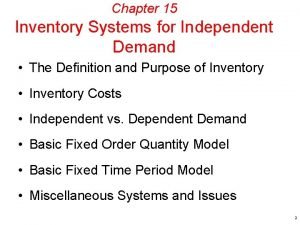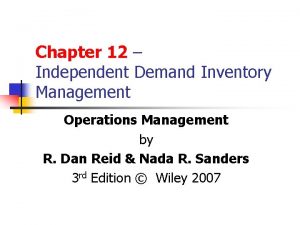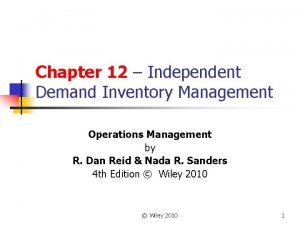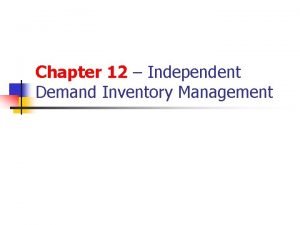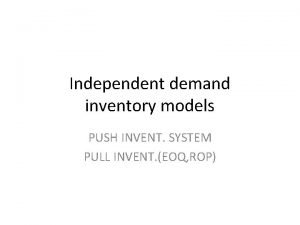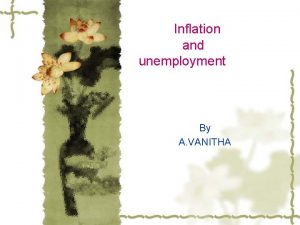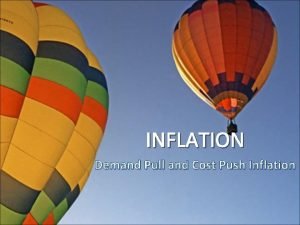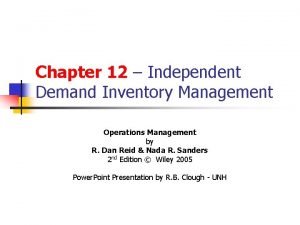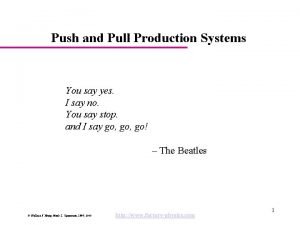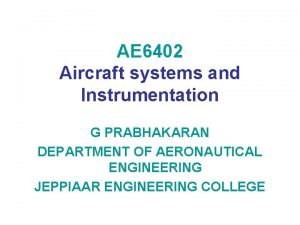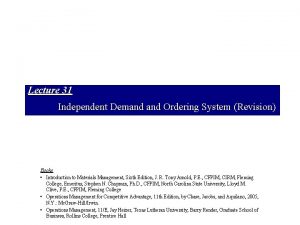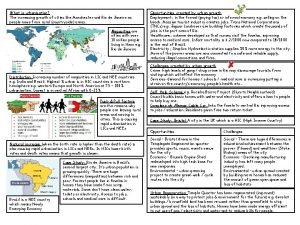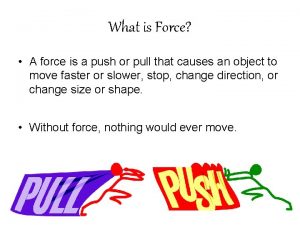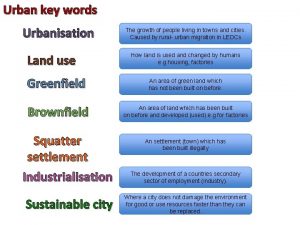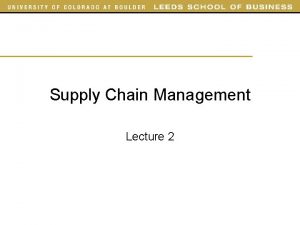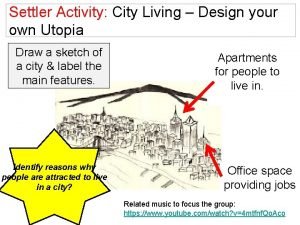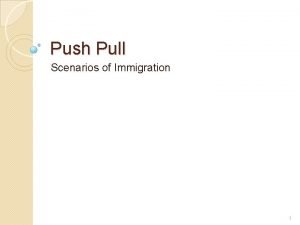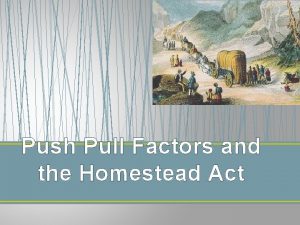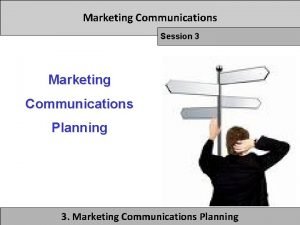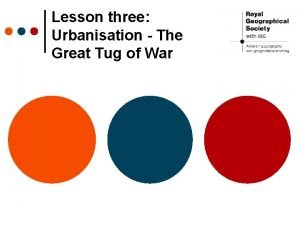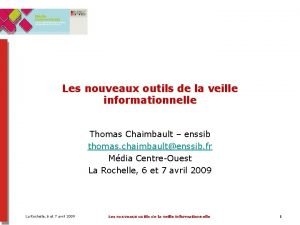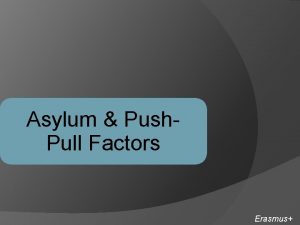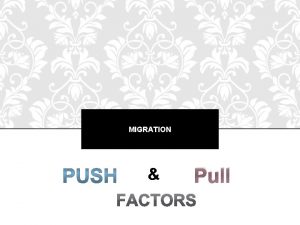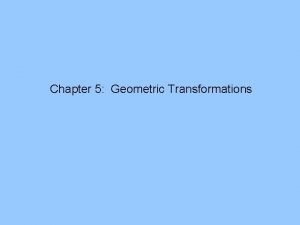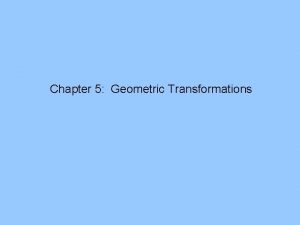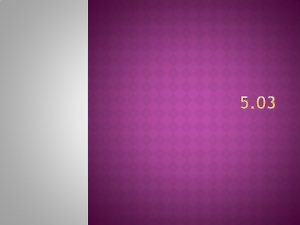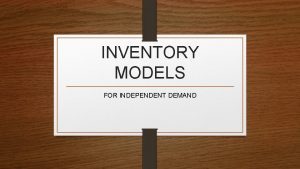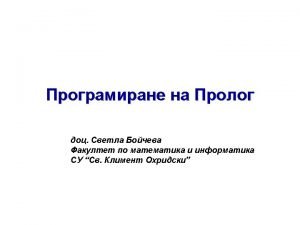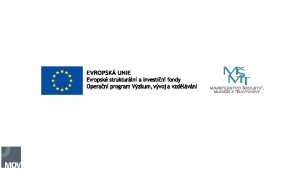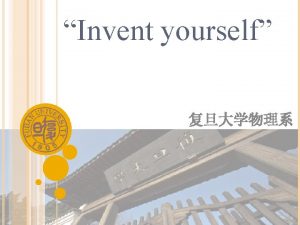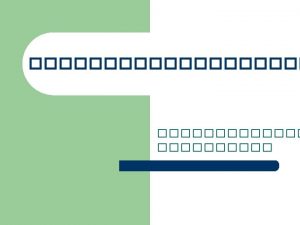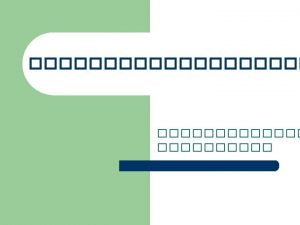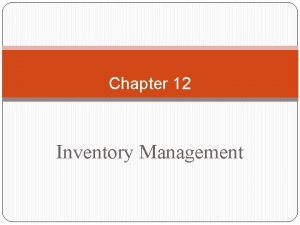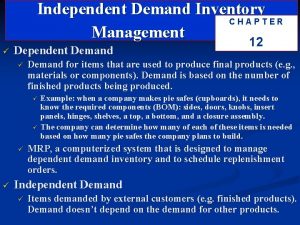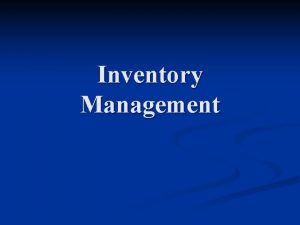Independent demand inventory models PUSH INVENT SYSTEM PULL

































- Slides: 33

Independent demand inventory models PUSH INVENT. SYSTEM PULL INVENT. (EOQ, ROP)

Learning objectives • Push Inventory Control • Pull inventory control • Reorder Point System

Pull vs. Push Systems • Pull: – Treat each stocking point independent of others. – Each orders independently and “pulls” items in. – Common in retail. • Push: – Set inventory levels collectively. – Allows purchasing, production and transportation economies of scale. – May be required if large amounts are acquired at one time. 3

Push Inventory Control • Acquire a large amount. • Allocate amount among stocking points (warehouses) based on: – Forecasted demand standard deviation. – Current stock on hand. – Service levels. • Locations with larger demand or higher service levels are allocated more. • Locations with more inventory on hand are allocated less. 4

Push Inventory Control TRi = Total requirements for warehouse i = Forecast demand at i + Safety stock at i = Forecast demand at i + z x Forecast error at i NRi = Net requirements at i = TRi - Current inventory at i z is from Appendix A Total excess = Amount available - NR for all warehouses Demand % = (Forecast demand at i)/(Total forecast demand) Allocation for i = NRi + (Total excess) x (Demand %) 5

Push Inventory Control Example Allocate 60, 000 cases of product among two warehouses based on the following data. Warehouse 1 2 Current Inventory 10, 000 5, 000 Forecast Demand 20, 000 15, 000 35, 000 Forecast Error 5, 000 3, 000 SL 0. 90 0. 98 6

Push Inventory Control Example Warehouse 1 2 Current Inventory 10, 000 5, 000 Forecast Demand 20, 000 15, 000 35, 000 Forecast Error 5, 000 3, 000 SL 0. 90 0. 98 Demand z % 0. 5714 1. 28 0. 4286 2. 05 TR 1 = 20, 000 + 1. 28 x 5, 000 = 26, 400 TR 2 = 15, 000 + 2. 05 x 3, 000 = 21, 150 NR 1 = 26, 400 - 10, 000 = 16, 400 NR 2 = 21, 150 - 5, 000 = 16, 150 Total Excess = 60, 000 - 16, 400 - 16, 150 = 27, 450 Allocation for 1 = 16, 400 + 27, 450 x (0. 5714) = 32, 086 cases Allocation for 2 = 16, 150 + 27, 450 x (0. 4286) = 27, 914 cases 7

Learning objectives • Push Inventory Control • Pull inventory control • Reorder Point System

Pull inventory control • Reorder Point System(continous review sys. ) – quantity ordered is constant – the time between orders varies • Periodic Review System – the time between orders is constant – the order quantity varies

Learning objectives • Push Inventory Control • Pull inventory control • Reorder Point System

Two Fundamental Inventory Decisions • How much to order of each material when orders are placed with either outside suppliers or production departments within organizations • When to place the orders

Inventory Costs • Costs associated with ordering too much (represented by carrying costs) • Costs associated with ordering too little (represented by ordering costs) • These costs are opposing costs, i. e. , as one increases the other decreases

Inventory Costs (continued) • The sum of the two costs is the total stocking cost (TSC) • When plotted against order quantity, the TSC decreases to a minimum cost and then increases • This cost behavior is the basis for answering the first fundamental question: how much to order • It is known as the economic order quantity (EOQ)

Balancing Carrying against Ordering Costs Annual Cost ($) Higher Minimum Total Annual Stocking Costs Lower Total Annual Stocking Costs Annual Carrying Costs Annual Ordering Costs Smaller EOQ Larger Order Quantity

Fixed Order Quantity Systems • Behavior of Economic Order Quantity (EOQ) Systems • Determining Order Quantities • Determining Order Points

Behavior of EOQ Systems • As demand for the inventoried item occurs, the inventory level drops • When the inventory level drops to a critical point, the ordering process is triggered • The amount ordered each time an order is placed is fixed or constant • When the ordered quantity is received, the inventory level increases • . . . more

ﺍﻹﻗﺘﺼﺎﺩﻱ ● ﻛﻤﻴﺔ ﺍﻟﻄﻠﺐ EOQ : ﺩﻭﺭﺓ ﻃﻠﺐ ﺍﻟﻤﺨﺰﻭﻥ Order quantity, Q Inventory Level Demand rate Time 0 Order receipt

Behavior of EOQ Systems • An application of this type system is the twobin system • A perpetual inventory accounting system is usually associated with this type of system

Determining Order Quantities • Basic EOQ • EOQ for Production Lots • EOQ with Quantity Discounts

Model I: Basic EOQ • Typical assumptions made – annual demand (D), carrying cost (C) and ordering cost (S) can be estimated – average inventory level is the fixed order quantity (Q) divided by 2 which implies • • no safety stock orders are received all at once demand occurs at a uniform rate no inventory when an order arrives –. . . more

Model I: Basic EOQ • Assumptions (continued) – Stockout, customer responsiveness, and other costs are inconsequential – acquisition cost is fixed, i. e. , no quantity discounts • Annual carrying cost = (average inventory level) x (carrying cost) = (Q/2)C • Annual ordering cost = (average number of orders per year) x (ordering cost) = (D/Q)S • . . . more

Model I: Basic EOQ • Total annual stocking cost (TSC) = annual carrying cost + annual ordering cost = (Q/2)C + (D/Q)S • The order quantity where the TSC is at a minimum (EOQ) can be found using calculus (take the first derivative, set it equal to zero and solve for Q)

ﺍﻹﻗﺘﺼﺎﺩﻱ Deriving Qopt TC = TC Q Co D = Q 2 0= Qopt = Co D + Q Cc Q 2 Cc + 2 C 0 D + Q 2 2 Co. D Cc Cc 2 ﻛﻤﻴﺔ ﺍﻟﻄﻠﺐ EOQ Proving equality of costs at optimal point So D Q Q 2 = = Qopt = Cc Q 2 2 So. D Cc

Example: Basic EOQ Zartex Co. produces fertilizer to sell to wholesalers. One raw material – calcium nitrate – is purchased from a nearby supplier at $22. 50 per ton. Zartex estimates it will need 5, 750, 000 tons of calcium nitrate next year. The annual carrying cost for this material is 40% of the acquisition cost, and the ordering cost is $595. a) What is the most economical order quantity? b) How many orders will be placed per year? c) How much time will elapse between orders?

Example: Basic EOQ • Economical Order Quantity (EOQ) D = 5, 750, 000 tons/year C =. 40(22. 50) = $9. 00/ton/year S = $595/order = 27, 573. 135 tons per order

Example: Basic EOQ • Total Annual Stocking Cost (TSC) TSC = (Q/2)C + (D/Q)S = (27, 573. 135/2)(9. 00) + (5, 750, 000/27, 573. 135)(595) = 124, 079. 11 + 124, 079. 11 Note: Total Carrying Cost = $248, 158. 22 equals Total Ordering Cost

Example: Basic EOQ • Number of Orders Per Year = D/Q = 5, 750, 000/27, 573. 135 = 208. 5 orders/year • Time Between Orders Note: This is the inverse of the formula above. = Q/D = 1/208. 5 =. 004796 years/order =. 004796(365 days/year) = 1. 75 days/order

Sensitivity analysis Annual Cost ($) Higher Minimum Total Annual Stocking Costs Lower Total Annual Stocking Costs Annual Carrying Costs Annual Ordering Costs Smaller EOQ Larger Order Quantity

Reorder Point System Order amount Q when inventory falls to level ROP. • Constant order amount (Q). • Variable order interval. 29

Reorder Point System LT 1 LT 2 Place 2 nd Place 1 st order Receive 1 st order 2 nd order LT 3 Place 3 rd order Receive 3 rd order Each increase in inventory is size Q. 30

Reorder Point System LT 1 LT 2 LT 3 Place 2 nd Place 1 st order Receive 1 st order 2 nd order Time between 1 st & 2 nd order Place 3 rd order Receive 3 rd order Time between 2 nd & 3 rd order 31

Reorder Point • Quantity to which inventory is allowed to drop before replenishment order is made • Need to order EOQ at the Reorder Point: ROP = d X LT d = Demand rate period LT = lead time in periods

 Inventory planning for independent demand items
Inventory planning for independent demand items Independent demand inventory management
Independent demand inventory management Inventory models for independent demand
Inventory models for independent demand Independent demand
Independent demand Independent demand inventory
Independent demand inventory Push vs pull inventory
Push vs pull inventory Futa inflation meaning
Futa inflation meaning Cost push inflation
Cost push inflation Independent demand vs dependent demand
Independent demand vs dependent demand Independent demand inventory
Independent demand inventory Independent demand inventory management
Independent demand inventory management Pull production system
Pull production system Push pull rod system in aircraft
Push pull rod system in aircraft Dependent demand vs independent demand
Dependent demand vs independent demand Ropplace
Ropplace Angle of pull ppt
Angle of pull ppt Push and pull factors of urbanisation
Push and pull factors of urbanisation Push and pull factors of urbanisation
Push and pull factors of urbanisation Magnetic force push or pull
Magnetic force push or pull Centripetal movement geography
Centripetal movement geography Push and pull factors of urbanisation
Push and pull factors of urbanisation Collaborative supply chain
Collaborative supply chain Strategia push i pull
Strategia push i pull Push and pull factors of urbanisation
Push and pull factors of urbanisation Push and pull scenarios
Push and pull scenarios Push-pull factors definition
Push-pull factors definition Push vs pull promotional strategy
Push vs pull promotional strategy Marketing objectives examples
Marketing objectives examples Push pull profile strategies marketing communications
Push pull profile strategies marketing communications Examples of market pull products
Examples of market pull products The great tug of war
The great tug of war Pull push
Pull push Push et pull veille
Push et pull veille Oros push pull
Oros push pull

